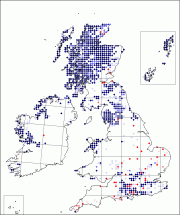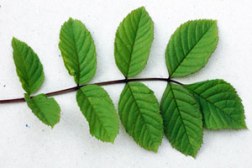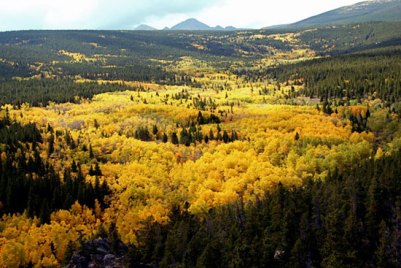Jim Povan from Aberystwyth University talked about his life as a reluctant population tree geneticist.
Past Work
Wayne Powell hired Jim as a research assistant at The Tree Research Group, where he went on to spend three years studying genetic variation in trees.
After a few years of skipping between jobs, the Northern Irish (N.I.) Government commissioned Jim to undertake a research project on Juniper genetics.
Juniper

Ireland was cut off England around 16,000 BC, which in turn was cut-off from Europe ~8,000 BC. Distinct species in England travelled quickly after Ireland was cut-off. The Juniper species in Ireland are therefore expected to be genetically separate.
Jim’s research found three things:Junipers in Ireland are fragmented (see image left). Gene flow is expected to be broken down, which decreasespopulation levels.
- Majority is characterised by 1 of 2 genotypes
- These genotypes are geographically localised
- Juniper is most diverse in N.I.
The areas of Juniper are also clustered together by genotype, meaning that there’s less gene flow. This is characterised by a decrease in berries.
Ash

Ash Dieback, a type of fungi known as Hymenoscyphus fraxineus, causes loss of leaves and crown dieback in infected trees. It is transferable throughout populations and causes huge amounts of damage.
The research project was aimed at learning how well ash could potentially disperse in case of population troubles, if it were to be reintroduced.
In order to do this, they needed to determine how effectively Ash reproduces.
Angiosperms were used and mitochondrial DNA from the chloroplast were analysed.
Seed movement and diversity were also tracked.
Similar to Juniper, it was found that most sites in N.I. were dominated by two genotypes. However all sites belong to one big cluster and therefore all trees are closely related.
Oak

Extensive hybridisation occurs between Quercus petraea and Q. robur. Both of these species are found in N.I., however not until after the ice-age.
Reid’s Paradox: How did these species get so far North in such a short space of time?
Originally only Q. robus was present.
- Colonisation by Q. robus acorns
- Pollination through Q. petraea eventually occurs
- Hybrids cross back to one of the two species
- Eventually, hybrids cross back to the same species
There is very little genetic difference between the hybrid and either of the two oak species.
When sampled, maternal DNA showed only that from Q. robus.
There is therefore increased diversity in Q. robus although decreased variation within the chloroplast.
The Ghosts of Giants

Asexual reproduction is a common feature among Populus.
Pando in Utah, although currently threatened, is potentially the largest living organism on Earth.
European Aspen (Populus tremulas) is almost all the same species in N.I. They must be clones of each other, suggesting that there was once a mid-ground between the plants which then died off.
It is possible that N.I. had the largest living organism when Aspen first colonised the country, however this has since died.
How?
- Massive spread,
- followed by fragmentation
- then asexual reproduction.
If the case is true then the organism would have been at least 400 hectares.
What does this mean for me?
Listening to a few seminars on genetic variation has made me think that actually, it’s pretty interesting learning. This may be something that I consider going into in the future and, although I’ve reaffirmed the belief that climatology and geography are aspects of science that interest me, I’ve also learnt that forestry isn’t something I want to spend my life studying.
Genetics is something I’ve always been interested in but never been able to follow.
Talks of PCRs and primers, in all honesty, terrify me… but it’s refreshing to reaffirm that there’s more to genetics than lab-work.
Any topic can be interesting if you’re engaged enough in the topic.
The talk was set out in a very interesting and easy-to-follow way. Jim explained everything succinctly but comprehensively, which as someone who doesn’t study either plants or genetics, I truly appreciated.
Even if I don’t go on to work on genetics, I’ve learnt that there are specific styles of teaching that help to keep the audience engaged and entertained, which is a skill I wish to learn.


Pingback: Thoughts of a tired blogger – Herpeton Travels